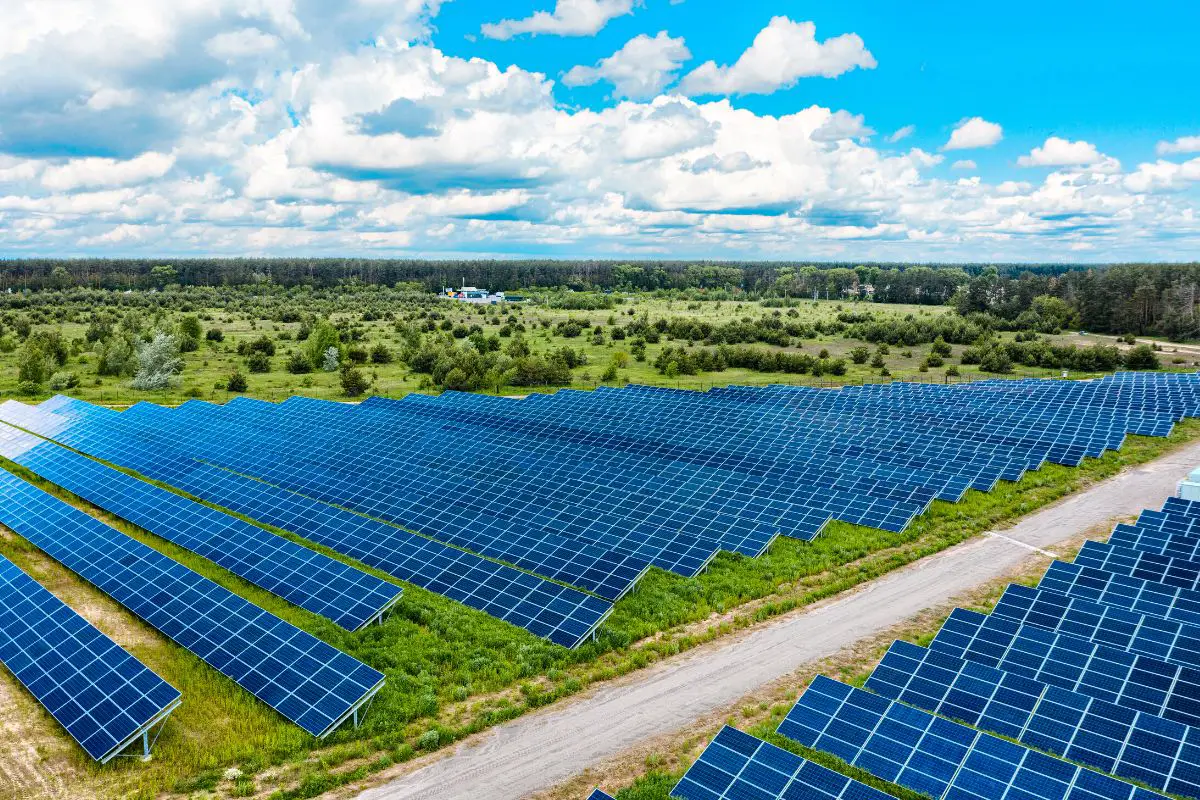Top 10 Largest Solar Power Plants in the World [+ Satellite Photos]
With countries across the globe scrambling to switch to renewable energy sources, it is no wonder that solar power is emerging as the most popular alternative.
To begin with, China is the unrivalled solar energy generator in the world. As of this writing, it has an output of around a whopping 392 GW. This solar titan is followed by the United States with 135.7 GW and Japan with 85 GW. Next on the list are other countries like Germany, India, and Italy.
But which are the world’s largest solar power plants or solar farms?
Surprisingly, there are plenty of countries beyond the top solar producers that have built the largest solar parks. In this article, we discuss 10 of the world’s largest solar power plants and find out some exciting facts about them.
(In case you are confused about the difference between solar farms and solar parks, this article will help.)
Without further ado, let’s get started.
10. NP Kunta (A.K.A. Ananthapuram) Ultra Mega Solar Park, India

The smallest on our list is still a behemoth! Spread across 11,000 acres in the state of Andhra Pradesh, this park currently generates around 978.5 MW. They are planning to bump up the capacity to 1.5 GW. The work will be distributed between the government-owned and private companies.
However, these figures don’t reflect the many difficulties the investors faced even before breaking ground. When you want to build 12 square miles worth of solar panels, that’s a lot of land to acquire. Couple that with other economic factors, and you’ll get the picture of common challenges for renewable projects in India. More on that below! But also on how it affects local communities.
However, the first phase of the project was commissioned in 2016 after they found a way to overcome these challenges.
This solar park was built from solar cells and modules that are domestically manufactured. The idea is to boost the ‘Make in India’ initiative by the Indian government. In fact, the plan is to set up India’s first Wind Solar Hybrid Power Project in the district and contracts have been signed with companies to set up wind energy projects.
9. Kurnool Ultra Mega Solar Park, India

This 1,000 MW solar park is located in the district of Kurnool in the state of Andhra Pradesh. The project was completed in two phases and the park is spread across a total area of 9.3 square miles.
To give you an idea, that’s around 4,500 football fields of standard length!
If the term “Ultra Mega” sounds confusing to you, let me add that it’s often applied to Indian solar plants with more than 500 MW of generating capacity. The commissioning of the park, at the time the world’s biggest, was done in March 2017.
During the construction phase of the park, both skilled and semi-skilled workers were used, who were sourced locally. Skill development centers were established in the area and the entire project generated around 2,500 jobs for the local workforce.
Water is often a significant challenge for huge solar parks as they are typically located in areas that are dry enough as it is. Add a big consumer into the equation, and you’ll get a not-so-bright picture of using unsustainable means to generate sustainable energy.
But Kurnool seems to have dealt with this issue quite well. The water for cleaning the panels is obtained from a reservoir created from rainwater harvesting.
8. Datong Solar Power Top Runner Base, China
If this solar plant looks like a giant panda perched on the shoulder of another giant panda, it’s because it’s supposed to look like that. The park designed to resemble China’s national animal was developed in a single stage and commissioned in mid-2016. The 1st phase, which is still ongoing, has a capacity of 1.1 GW, and the next two phases will increase it to 3 GW.
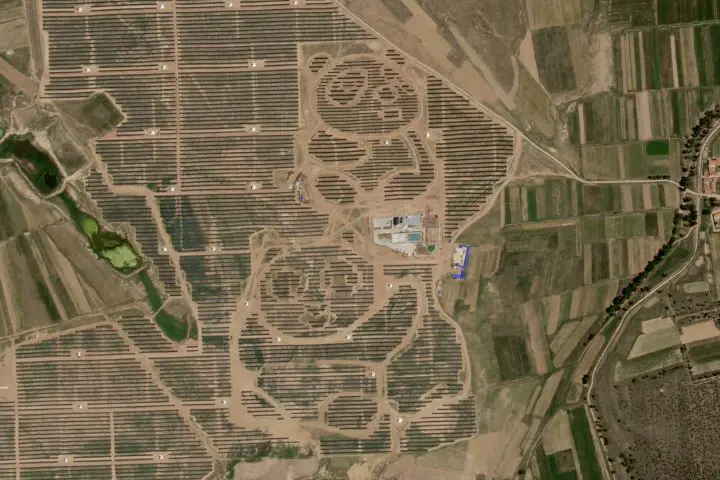
Rome wasn’t built in a day, but it wasn’t built by a single pair of hands either. As with most if not all gigantic solar parks, multiple large energy conglomerates were involved in the development of the project. At the moment, the site is fully owned by China Power International Development.
Located in Datong City in the Shanxi province, the plant covers an area of 0.39 square miles.
Now, “cute” isn’t the first word that comes to mind when you talk about solar farms. But that is good enough to earn it the title of the cutest solar park in the world right now!
7. Noor Abu Dhabi Solar Power Plant, UAE

If you don’t know this, the term “Noor” means light in Arabic. That seems to be the perfect name for a site that uses 3.2 million solar panels to generate around 1.177 GW of solar power. The plant started its commercial operation on April 30, 2019.
But it’s not just about gigawatts of energy. Noor has the capacity to reduce Abu Dhabi’s carbon-di-oxide emissions by around one million tons. The monocrystalline solar panels are oriented in an east-west design to make maximum use of solar irradiation.
There is one problem though. The all-pervasive dust from the desert can cover the panel surfaces within hours, reducing the generating capacity.
But does it mean they built 3,3 million panels just to see how inefficient they can be? Not at all! The problem is solved by using 1,430 dry-cleaning robots that travel 800 kilometers every day to clean all the panels. Most importantly, the cleaning process is conducted without using a single drop of water.
Astonishing, isn’t it?
Abdulla Al Kayoumi, the CEO of the plant, says on their website: “The operation and maintenance model of Noor Abu Dhabi is driven by technology that suits our harsh environment and which enables us to achieve optimal performance.”

6. Tengger Desert Solar Park, China

The Tengger Desert is the fourth largest desert in China and is rich in solar and wind energy resources. With a relatively higher altitude above sea level, the area also enjoys long hours of sunshine for most parts of the year.
And the 21st-century rule is: where there’s a desert, there’s bound to be a solar power plant. The eponymous solar park has a capacity of 1.5 GW, which translates to power for over 600 thousand homes, and is located in the Ningxia Hui Autonomous Region. The total investment in the project was 20 billion yuan (around 3,2 billion dollars at the time) and it was developed by the State Grid Corporation of China. It occupies a large area of 10,378 acres.
The electricity generated by the plant will be supplied across six provincial-level areas. The length of the transmission channel will be close to 1,467 kilometers. In fact, before the commissioning of the Huanghe Hydropower Hainan Solar Park, the Tengger Desert Solar Park was the largest solar station in China.
Once all the phases of the project are complete, the generating capacity will touch 3 GW. In that stage, it will have the ability to prevent the burning of 1.92 million tons of coal annually!
Don’t let the “hydro” part confuse you. This giant is solar only, and the word was inherited from the company’s name.
5. Benban Solar Park, Egypt

The valley of the Nile is home to more than one gargantuan structure, and I’m not talking about the pyramids.
With more than 41 solar power plants, the Benben solar park has an energy output of 1,650 MW. Spread over an area of 14.28 square miles, it is the largest solar project in Africa. A 16-kilometer-long water pipeline was constructed to bring water from the Nile to the project site.
Sitting in the desert between Aswan and Cairo, the park faces an extreme climate with temperatures touching 50° Celsius in summer. The project site was chosen based on solar energy field inputs from Nasa, and other international scientific bodies.
But as much as it’s invaluable for solar power, heat spells a nightmare for people involved in building it. Engineer Hadeer Khalifa, who has worked on the project for four years, mentions, “My colleagues had warned me that I would have to work under a blazing sun, in conditions that were difficult to bear.” She further adds, ”I can say that I have grown a lot in this job, and they are very proud of that.”
Khalifa was one of around 18,000 workers who took part in the construction, according to a 2016 report. This same report estimates environmental and societal risks as negligible to minor, with the locals being mostly positively inclined towards the project.
Technically, Benban is a pioneering project as it is the first to use bifacial solar modules. This means the energy can be produced from both sides of the panel, a breakthrough technology in solar power generation. What this means is, the bottom face of the panel uses the sunlight reflected off the ground to generate energy.
4. Mohammed Bin Rashid Al Maktoum Solar Park, UAE
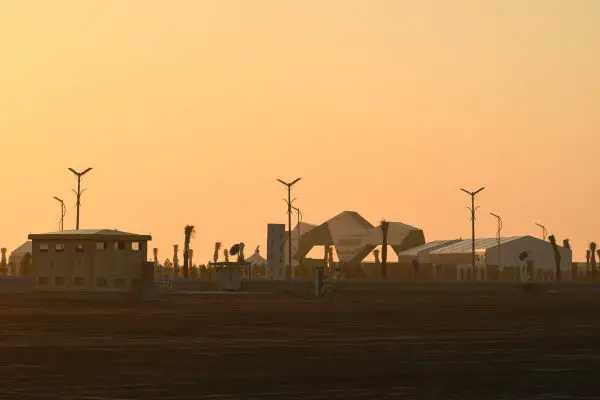
Say hello to a solar mammoth that works both day and night.
UAE has decided to invest AED 600 billion until 2050 towards the generation of clean energy. The solar park named after Dubai’s ruler is a key driver of this initiative and generates over 15 percent of the UAE’s total energy requirement.
As Mohammed Bin Rashid himself put it, “Every investment in the development of clean energy sources is at the same time, an investment to protect the environment for future generations.”
With a total area of around 30 square miles, it is one of the largest single-site solar parks in the world. The project was developed in five stages and right now, the total generating capacity is 2,327 megawatts.
Beyond the standard photovoltaic (PV) panels, the plant also uses concentrated solar power (CSP) technology. As per the plans, the capacity will touch 5,000 MW by 2030. At that point, the plant will result in the reduction of 6.5 million tons of carbon dioxide emissions annually.
The area also has an R&D center, outdoor labs, and a solar testing and certification facility. For visitors, there are more than 30 interactive exhibits that demonstrate the various aspects of renewable energy.
3. Pavagada Solar Park, India

Spread over a vast area of 13,000 acres covering five villages, the Pavagada solar park is currently ranked third among the world’s largest solar farms. The farm can generate 2,050 MW of power which can prevent the emission of 70 million tonnes of carbon dioxide in a year.
One interesting feature of the project is that the entire land was leased from farmers. The farmers are being paid around $323 per year per acre as compensation. The rate is escalated by 5 percent every two years to account for inflation.
The method not only allowed the farmers to retain land ownership, but the developers too avoided the complex bureaucratic processes associated with the purchase of land. This led to the quick completion of the project and faster generation of renewable energy.
But not everything is sunshine and roses (pun intended). Since this is a drought-prone area, obtaining a steady supply of water is a challenge. A single wash of the panels requires 14,000 to 40,000 kiloliters of water. Solutions like digging borewells and rainwater harvesting have been implemented to address the issue. However, more thought towards meeting the water demands will be needed in the coming years.
Beyond that, reports mention that, since local farming land was leased for developing the project, many farm laborers lost their livelihood in the long run. In other words, much of the burden of this supposedly ethical project was and remains carried by the poorest. So, for future solar projects on agricultural land, prioritizing employment for landless workers should be a priority.
2. Huanghe Hydropower Hainan Solar Park, China

The second largest photovoltaic park in the world delivers 2.2 GW to the grid. Quite simply, an output of above 2GW is a huge number, even for a solar farm. In comparison, the largest solar farm in the US, the Solar Star, generates a “meager” 579 MW of energy.
The park is a state-owned utility that was built in five stages and the reported cost of the project is close to USD 2.2 billion. Located in Gonghe County, Qinghai, the park has more than 7 million PV modules spread over 1,390 acres.
The project also has an energy storage capacity of 02.86 MWh and is connected to an ultra-high voltage power line that extends over 1,587 kilometers across multiple provinces. Let me add that China has plans to build the world’s largest super grid that can transmit five times more energy than standard power lines.
Research has also been carried out on the impact of the solar PV setup on the local environment around the park. This has indicated a rise in soil moisture and improved vegetation growth. In fact, site authorities have allowed around 600 sheep to graze inside the park to control the grass growing under the panels.
And guess what?
The image of sheep grazing under the panels went viral on social media in no time.
1. Bhadla Solar Park, India
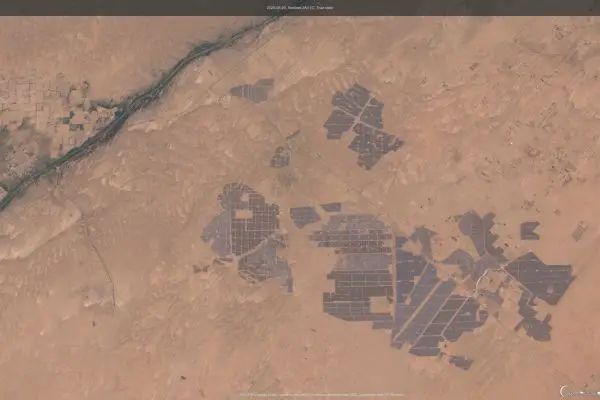
Look up any list of interesting facts about solar power and you’ll find the name of the Bhadla Solar Park in it. And not without reason.
Spread across 14,000 acres in the Thar desert of the Rajasthan district, the Bhadla Solar Park is the largest solar power plant in the world. With a massive generating capacity of 2.25 GW, it has over 10 million solar panels that soak the sun under average temperatures ranging between 46-48 degrees Celsius.
The project was divided into four stages and started with an investment of $1.4 billion. It was developed by multiple companies and the final stage was completed in 2020. The generated electricity can power over four and a half million households.
As expected, the desert region is prone to frequent sandstorms. So the plant, much like Noor Abu Dhabi, uses robotic cleaning technology that is operated by a cloud-based control system. Moreover, the use of water-free cleaning technology can save over 2 billion liters of water in the 25 years of operation of the plant.
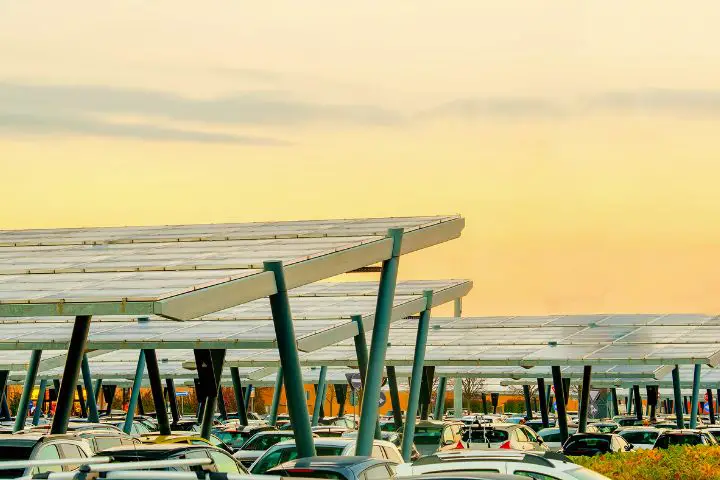
Besides, the world’s largest solar power plant has also opened up opportunities for the locals in the surrounding villages.
As the villager 18-year-old Mukhtiyar Ali told the BBC, “Most of the boys in my village did not study much. They were not ambitious, as our life was limited to the village, and our parents are farmers or into breeding cattle. But since the construction of the park, I realized the world is much bigger than my village.”
However, a few other locals, especially farmers and cowherds, are not happy with the turn of events. Since the land they grazed their cattle on is now covered with millions of panels, they feel their livelihood could be at stake.

